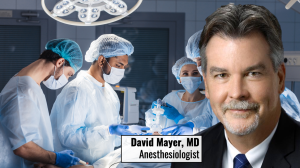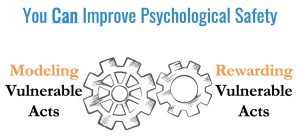Healthcare Excellence Requires Problem-Solving and Psychological Safety

Whether we aim to be a “Lean” hospital or have a culture of safety (or, ideally, both), this level of excellence is built upon a culture of continuous improvement. As Greg Jacobson, MD, an emergency medicine physician, and CEO of KaiNexus says:
“We cannot have a culture of continuous improvement without a culture of learning from mistakes.”
Being able to learn from mistakes requires not just problem-solving skills, but also a culture of psychological safety.
We cannot solve problems unless the team and leaders are aware of them. What happens when medical professionals are afraid to speak up about mistakes, problems, or opportunities for improvement? Or if they just think speaking up won’t change anything?
A Mistake That Harmed a Patient and Changed a Career
I can share one story that illustrates this from my book, The Mistakes That Make Us: Cultivating a Culture of Learning and Innovation, as shared with me in an episode of the “My Favorite Mistake” podcast by anesthesiologist David Mayer, MD. As a resident, in 1985, David was assigned to provide anesthesia care for a patient’s right-sided inguinal-hernia-repair procedure.[i]
 Before the start of the procedure, the attending surgeon was delayed by the need to answer a question outside the room. The resident surgeon made an incision on the patient’s left side.
Before the start of the procedure, the attending surgeon was delayed by the need to answer a question outside the room. The resident surgeon made an incision on the patient’s left side.
Two minutes later, the attending walked in, looked, and said, “I thought this was a right-sided inguinal hernia.” That’s right—the incision had been made on the incorrect side. Not right but wrong. Not right but left.
“Everybody was horrified,” David recalls, including the shaken surgical resident who dropped to one knee and had to be helped to a chair in the corner of the room to gather herself. The surgical attending calmly closed the unnecessary incision and performed the correct procedure on the correct side. Because of the need to cover the unnecessary incision, “There would be no hiding the mistake” physically, as Dr. Mayer recalled.
Later, the patient smiled at David in the recovery room and exclaimed, “Today’s my lucky day! The surgeon discovered I had two hernias and fixed them both! I’ll only miss one day of work, not two!”
David was “dumbfounded” to learn that the attending surgeon had lied to the patient about a second hernia instead of disclosing the mistake. After what felt like an eternity, David replied, “Yes, it is your lucky day.” As a resident, David feared it would be a career-ending move if he contradicted the surgeon and spoke up about the mistake.
“The shame-and-blame culture of our medical profession guaranteed that it would be only a matter of time before our team suffered the consequences of our error. I was terrified this medical error would damage my professional career, and I wondered if I would be disciplined by the hospital, suspended by my department, or face criminal charges,” instead of being able to focus on the patient.”[ii]
Had this mistake been revealed, David says, any investigation would have focused on assigning blame. “Every resident physician was conditioned early in training that someone is at fault when things go wrong,” he says, instead of looking for problems with processes and systems.
Performing the incision on the wrong side illustrates the concept of a systemic error, since many people were involved. We don’t know the root cause in this case, but we would want to ask constructive questions in the immediate aftermath for the purposes of learning and process improvement. How could this occur? What allowed it to happen? How far upstream did any miscommunication begin? Did somebody drape the wrong side of the patient? If so, why?
Perhaps the resident erred by not waiting for the attending to arrive before starting. Or the attending had previously yelled at (or more subtly punished) the resident for waiting to start cases, which might have led her to go ahead and start. Or the surgery schedule had fallen behind, and there was pressure to keep things moving. I can only speculate here, and doing so would be a mistake during a real problem-solving situation.
Following a Slip with a Bad Decision
The attending surgeon was the highest-ranking person in the room. He was involved in the initial mistake. The resident surgeon made the wrong incision, but the attending surgeon’s job is to supervise and teach. Surgical timeouts and checklists weren’t yet being used in 1985.
David knew the attending surgeon had made a bad decision by lying to the patient about finding the second hernia. It may be surprising, but healthcare has learned that patients are less likely to file a lawsuit after a mistake if the surgeon admits it and apologizes. We’re all human. We all make mistakes. We all appreciate honesty, empathy, and an apology.
The attending surgeon had consciously decided to cover up the wrong-side mistake. The wrong-side incision was a systemic failure. The cultural elements involved in hiding the mistake are even more systemic. If the attending surgeon feared punishment, I can understand why he didn’t speak up. It illustrates why leaders need to remove barriers to honest disclosures, including taking steps that create the conditions for higher levels of psychological safety.
The Anesthesiologist’s Mistake Sparked His Patient-Safety Career
So why did David refer to this incident as his favorite mistake? David says his mistakes were, first, not challenging the attending surgeon and, second, not telling the truth to the patient, even though being open and honest “was the right thing to do.” But again, speaking up is not a matter of character—it’s the result of culture.
David says that during his seven years of formal medical-school education, “Nobody ever talked about what happens when we make an error or harm a patient. I also never had a discussion about what we do and how we respond when an error occurs.”
David describes the behaviors he saw that day as “deny and defend, lie about it, get away with it.” Doing this keeps people out of trouble, but it doesn’t lead to improvement. “When we hide errors like that—when we bury them within our own little silos — we don’t learn. The mistake that I’ve lived with for 35 years has shaped my career in many ways.”
David learned how hierarchical and punitive workplace cultures prevent people from feeling safe. Residents might not feel safe challenging an attending, and nurses or operating-room techs might not feel safe challenging the physicians. It’s understandable when people don’t speak up if doing so creates the risk of loss or harm on personal or professional levels.
The wrong-side surgery incident sparked David’s passion for improving patient safety, not just for his anesthesia patients but also more broadly. Beyond his direct patient-care work, David has served as the executive director for the MedStar Institute for Quality and Safety at the Maryland-based MedStar health system and as CEO of the non-profit Patient Safety Movement Foundation.
David has worked tirelessly to improve systems and cultures so others would feel safer, which makes it safer for patients, as they benefit from improvements that occur when learning is the focus instead of naming, blaming, and shaming. This also relieves providers from carrying the burden of lying about and hiding their mistakes.
What is Psychological Safety and How Do We Cultivate It?
A culture of learning from mistakes requires that each person feels a reasonably high level of psychological safety. Timothy R. Clark, PhD, succinctly defines psychological safety as “a culture of rewarded vulnerability.”[iii]
A “vulnerable act” exposes us to the risk of harm or loss, personally or professionally. We’re describing an action, not the person. Basically, any interaction between two or more human beings can be vulnerable, some more than others. A specific act might be vulnerable to some degree for a specific situation. Unlike physical safety, where we might say a particular act is inherently risky for all (such as working up high without a safety harness), the perceived level of risk for acts, such as pointing out a mistake, is situational and individual.
The level of psychological safety that we feel will vary from person to person. You might feel safe in one team, while a colleague feels relatively unsafe in that same setting. Our feeling of safety could vary due to our differing interactions with leaders and members of that team. We each might be influenced differently by memories of bad experiences in previous workplaces, where speaking up and admitting a mistake led to being punished or fired. It’s a matter of culture.
Tim’s longer definition says:
“Psychological safety is a social condition in which you feel:
- Included
- Safe to learn
- Safe to contribute
- Safe to challenge the status quo
… all without fear of being embarrassed, marginalized, or punished in some way.”
Those four bullet points are what he calls The 4 Stages of Psychological Safety (and I highly recommend Tim’s book of that title). At the highest levels of psychological safety, we feel safe to challenge the status quo, all of which leads to a culture of innovation and success.
Saying things like “I don’t know how to do this” or “I could be wrong” are prime examples of behaviors that must be modeled and rewarded by leaders, in addition to admitting mistakes. Doing so consistently creates the conditions for others to feel safe enough to follow their lead, and it’s far more effective than cajoling people to “be more vulnerable” or to “be brave.” When people feel safe asking questions about how to do their work, many mistakes are prevented.

When healthcare leaders, starting with the CEO, model vulnerable acts, such as admitting mistakes in a way that focuses on learning instead of shame and punishment, that gives permission for others to do the same. When leaders then reward caregivers for following their lead, that puts on a path where mistake-free care and zero harm is possible.
[i] My Favorite Mistake, “Episode 70, David Mayer, PhD,” https://markgraban.com/mistake70.
[ii] Mayer, David, MD. How to Stay Safe When Entering the Healthcare System: A Physician Walks Across the Country to Raise Awareness of the Need to Improve Healthcare Safety (Irvine, CA: Universal Publishers, 2022).
[iii] Clark, Timothy R., PhD, The 4 Stages of Psychological Safety (Oakland, CA: Berrett-Koehler Publishers, 2020).








Leave a Reply